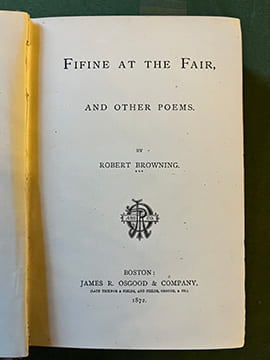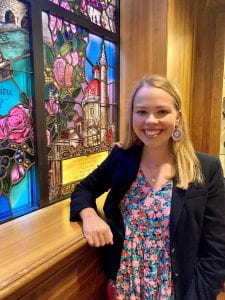by Anna Clark, Master’s Candidate in History and Armstrong Browning Library Graduate Assistant
This article complements the exhibit “Digging in the Archives: Recent Scholarship at the Armstrong Browning Library” on display in the Hankamer Treasure Room, summer and fall 2024. The section on the scholarship of Kevin Morrison–in particular, his book Victorian Liberalism and Material Culture: Synergies of Thought and Place–contains a QR code that redirects to this page. The list of artifacts that Morrison used to describe the connection between Robert Browning’s home decor and his poetry are listed below. All of these items are somewhere on display here at the Armstrong Browning Library. See if you can find all of them!

In his book, scholar Kevin Morrison explores the connection between ideology and material culture. Specifically, Morrison examines the living spaces of four Victorian authors and intellectuals—John Stuart Mill, Matthew Arnold, John Morley, and Robert Browning—to discover how the environment in which each writer worked influenced their liberal politics. To write the chapter “Robert Browning’s Domestic Gods,” Morrison studied many of the items on display here at the ABL that were once in the Brownings’ home.
List of Artifacts to Find:
- Velvet Folding Chair

Velvet Folding Chair, originally in the salon of Casa Guidi
This Italian velvet folding chair was one of the antique items that Robert and Elizabeth Barrett Browning bought to furnish the salon in their house in Florence, Italy, called Casa Guidi. Originally covered in red velvet, the curule-style chair has since been reupholstered in green velvet. The arms and legs of the chair are made of walnut and display many hand-carvings. Elizabeth described these carvings as “all grinning heads & arabesque” (The Brownings’ Correspondence 2005: 103-4, quoted in Morrison, 198).
This folding chair appealed to the Brownings because of both its comfort and its second-hand nature. Morrison explains that at this time, furnishing one’s home with previously owned goods would have been seen as undesirable to many in the English middle class, but for Robert and Elizabeth, the struggling poets they were, saving money on furniture was a wise option as well as in line with their Evangelical views of economy (198-200). Additionally, Robert wanted to invoke the culture of Italy by collecting antiques and art that reflected its aristocratic history (204). This love of Italy and its Renaissance past is seen in many of Robert’s poems.
- Browning Family Grandfather Clock

Browning Family Grandfather Clock
In his book, Morrison describes the significance of this grandfather clock, which belonged to the Browning family and was on display at four of their family residences. For Morrison, the clock tells the story of a family who “emphasized religious principle of self-denial” (186). Even though Robert Browning’s father was well-off, this Bates of Huddersfield bracket clock is more practical than decorative in appearance. It is made of rosewood on a brass-mounted base with little ornamentation. As Morrison explains, “[the clock’s] modest appearance calls attention to time itself–and, by extension, the limited quantity of time, the uncertainty of days and the importance of the present moment” (186). This reminder of one’s own mortality was especially important in an Evangelical household like the Brownings’.
This clock kept time throughout the 20th-century and will still chime if wound. (The ABL staff does not wind the clock for preservation purposes.)
- Elizabeth’s Writing Desk, Letter Tray, and Chairs

Elizabeth Barrett Browning’s writing desk, letter tray, and chair
At this writing desk, Elizabeth Barrett Browning wrote many of her poems and conducted her correspondence. As an educated Evangelical woman who read and wrote broadly, Elizabeth shared her husband’s liberal views. In particular, she was well-informed on the current political scene in Florence and wrote some poems advocating for Italian independence.
- Prie-Dieu

The Brownings’ prie-dieu, which is the French name for a prayer kneeler
This prie-dieu, or prayer kneeler, was owned by the Brownings when they lived at Casa Guidi in Florence. Pen, their only son, later inherited the prie-dieu and used it in his Venetian home, Palazzo Rezzonico. As Evangelicals, the Brownings dedicated time to prayer both at church and at home.
- Salon at Casa Guidi by George Mignaty (1861)

Mignaty’s Painting of the Salon at Casa Guidi
This is George Mignaty’s 1861 painting Salon at Casa Guidi, which Robert commissioned the artist to paint shortly after Elizabeth’s death. Robert wanted a memento of their sitting room in Florence as it looked when Elizabeth was alive.
Kevin Morrison’s observations about the Brownings’ Evangelical mentality and Robert’s appreciation for Italian art are evident in the painting. Morrison uses Elizabeth’s description of their home as being in “graceful disorder” (Browning Correspondence 1998: 322, quoted in Morrison, 193) as he describes the crowded look of the salon. For the Victorians, the excessive ornamentation of the Brownings’ sitting room and the many pieces of antique furniture and art would have created a sense of home and comfort.
Many of the items on this list can be seen in the painting. In particular, the green Italian folding chair can be seen in the lower lefthand corner of the painting, upholstered in its original red velvet. Additionally, Elizabeth’s fan, which is in the ABL’s possession, is seen laying on the green deck chair in the lower right corner of the painting. The second-hand mahogany bookcase which stands along the left wall originally belonged to a convent and indicates both the Brownings’ love for beautiful things and their Evangelical outlook on economy. In his book, Morrison also delves into the significance of the Italian religious tapestry panels hanging on the back wall of the salon, which represent an intersection of art, history, and religion.
- The Fan in Mignaty’s Painting of the Salon

Elizabeth’s fan which is laying on the chair in the painting of the salon at Casa Guidi
This fan is believed to be Elizabeth’s–in particular, the one laying on the green chair in Mignaty’s painting of the salon at Casa Guidi.
- Copy of The Guardian Angel by Guercino

The ABL’s copy of the Guardian Angel painting, which was inspiration for Robert Browning’s Poem, “The Guardian Angel”
The Guardian Angel, or L’angelo Custode, was painted in the 17th century by Italian Baroque artist Giovanni Fransceesco Barbieri, who was known as “Guercino.” This particular painting is a copy of the original, which hangs in a small chapel in Fano, Italy, where Robert Browning one day visited with his wife Elizabeth. Robert wrote the poem “The Guardian Angel” based off his perceptual and spiritual engagement with the painting. In the poem, Browning’s narrator expresses a wish that the child’s guardian angel in the painting would also minister to him. The narrator desires a supernatural encounter after admiring Guercino’s painting; in other words, the art inspires a spiritual awakening in the viewer.
As Morrison explains in his book, “works of fine art were viewed with ambivalence by Evangelicals…Many worried about art lacking biblical sanction” (190-91). This particular painting of a child’s guardian angel would have been troublesome for some Evangelicals as the existence of guardian angels had been a long-standing Christian tradition but not one that had explicit biblical exegesis. However, as Morrison explains, Robert Browning appreciated art as it “opened not only the representational world depicted on the canvas but also the historical world of its creation” (191). Browning’s perspective on art influenced how he interacted with Guercino’s The Guardian Angel painting.
Browning’s poem “The Guardian Angel” was the topic of Kevin Morrison’s 2023 Browning Day lecture, in which he explained the poet’s inspiration and pedagogy in writing the poem. The lecture complemented this chapter on “Robert Browning’s Domestic Gods” in Victorian Liberalism and Material Culture.
To learn more about Kevin Morrison’s research and past visits to the Armstrong Browning Library, the following links are provided:
Also be sure to check out the work that other researchers and scholars have conducted at the ABL using our materials in the exhibit “Digging in the Archives: Recent Scholarship at the Armstrong Browning Library.” In particular, if you are interested in Sue Brown’s research on Julia Wedgwood, consider stopping by our Dotson Wedgwood china and pottery display downstairs on the first floor.*
*(The Dotson Wedgwood Collection here at the ABL was donated by Sue Anthony Dotson and her husband William Dotson and remains one of the largest collections of Wedgwood pottery pieces in the United States. Robert Browning and Julia Wedgwood, the great-granddaughter of Josiah Wedgwood who founded the Wedgwood pottery company in 1759, were correspondents.)

 acclaimed novels written with her husband Tom McNeal. She received her M.A. in fiction writing from Syracuse University and has been the recipient of two Armstrong Browning Library visiting research fellowships. These research visits to the ABL assisted McNeal in writing her latest novel, The Swan’s Nest, which explores the love story of two famous 19th-century poets, so near and dear to our library: Robert Browning and Elizabeth Barrett Browning. The Swan’s Nest, which was just released this March, covers the beginning of the Brownings’ courtship in 1844 leading up to their wedding in 1846 and their subsequent flight to Italy. In future works, McNeal intends to explore more of the Brownings’ 19th-century world as The Swan’s Nest is the first book in a planned trilogy.
acclaimed novels written with her husband Tom McNeal. She received her M.A. in fiction writing from Syracuse University and has been the recipient of two Armstrong Browning Library visiting research fellowships. These research visits to the ABL assisted McNeal in writing her latest novel, The Swan’s Nest, which explores the love story of two famous 19th-century poets, so near and dear to our library: Robert Browning and Elizabeth Barrett Browning. The Swan’s Nest, which was just released this March, covers the beginning of the Brownings’ courtship in 1844 leading up to their wedding in 1846 and their subsequent flight to Italy. In future works, McNeal intends to explore more of the Brownings’ 19th-century world as The Swan’s Nest is the first book in a planned trilogy.



























 Anna Clark
Anna Clark